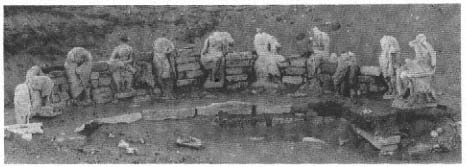Hellenistic Kings and Archaic Poets
The presentation of this type of literary portrait as a kind of cult image, on the one hand, and the more detailed, biographical approach that appealed to the viewer's own literary training, on the other, are not mutually exclusive. Rather, the spiritual aura only intensified the appreciation of the portrait as a work of art and erudition. Generally speaking, in Hellenistic art the object was expected to offer a whole spectrum of associations. This is why, for example, among freestanding sculpture in the round, it was the statue groups that were particularly popular. A multiplicity of figures allowed the message to be enriched with several layers of meaning, and the Hellenistic world, as the inscriptions also reveal, was an extraordinarily communicative place.

Fig. 91
Exedra with portraits of famous poets and philosophers. Third century B.C.
Memphis, Serapeion.
In the area of literary portraiture as well, the statue group seems to have been of central importance.
We have already seen one example of a meaningful grouping of figures, replete with learned allusions, on the Archelaos Relief. A group of famous poets, original works most likely of the later third or early second century, has been found in the sanctuary of Serapis at Memphis (fig. 91).[27] Twelve over-life-size statues of "ancient" poets and thinkers were arranged here in a semicircle around the seated figure of Homer. Their display, however, represents a renovation of the monument in late antiquity. Once again, the sculptor seems to have used innovative physiognomic characterization to differentiate the various literary genres.
The exedra was placed for maximum effect at the egress of a grand processional street. In earlier times, such an ambitious group would have been conceivable only for mythological heroes or as a gallery of ancestor portraits of a royal house. Astonishingly, among the fragments found at Memphis were two fragmentary heads wearing the royal diadem, one of them a youth. Apparently members of the ruler family responsible for the monument were also depicted among or alongside their intellectual heroes. In other words, the intellectual giants of the past would have been presented as good counselors to the king, as the source of his wisdom and authority. Beyond the immediate historical
or political circumstances, this is clearly a celebration of universal learning as a quality of the good ruler. The cult of learning that manifested itself in the hero shrines of Hellenistic cities finds a close parallel in the public image cultivated by the Ptolemaic kings.
The meagre state of the surviving evidence does not allow us, unfortunately to reconstruct the manner in which retrospective portraits were displayed in other contexts, such as the urban heroon, like the Archilocheion on Paros, or the gymnasia. We may suppose, however, that the association of local literary heroes with their native city would most likely have provided the backdrop for the display of the corresponding portraits, and that cult legends of the type we have preserved for Bias and Archilochus played a central role in this context as well.